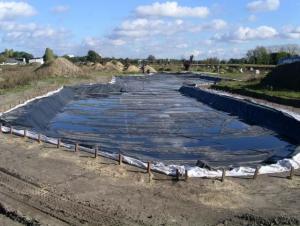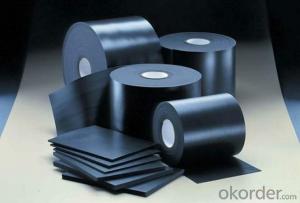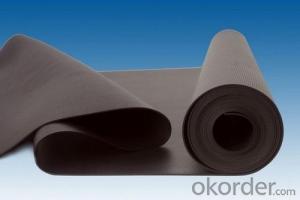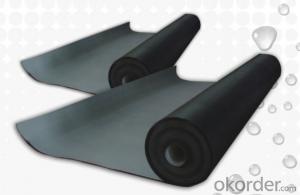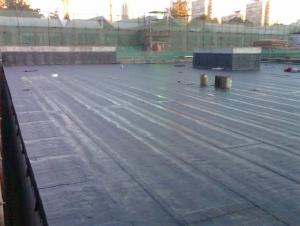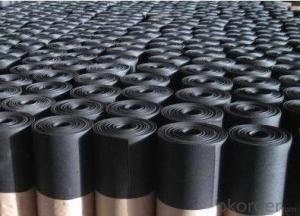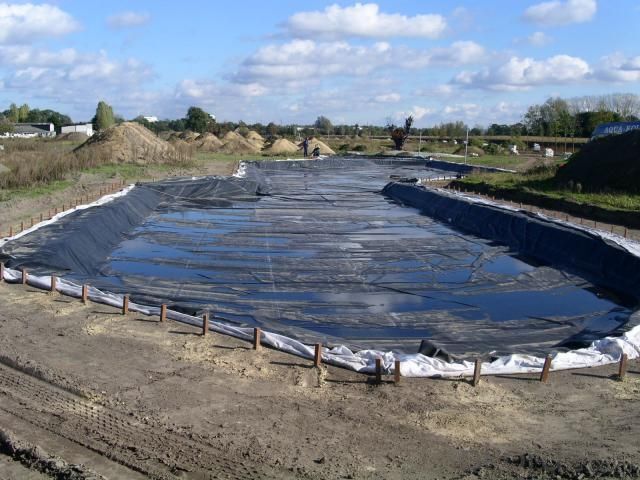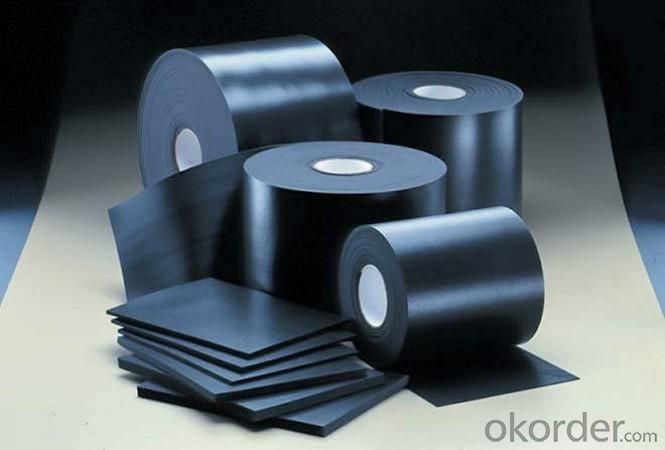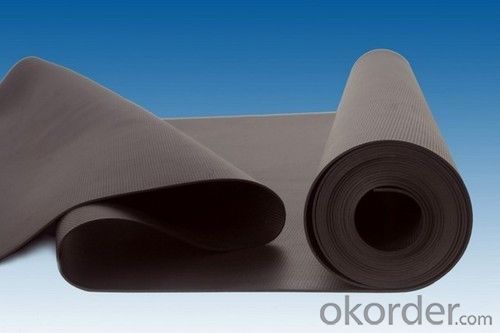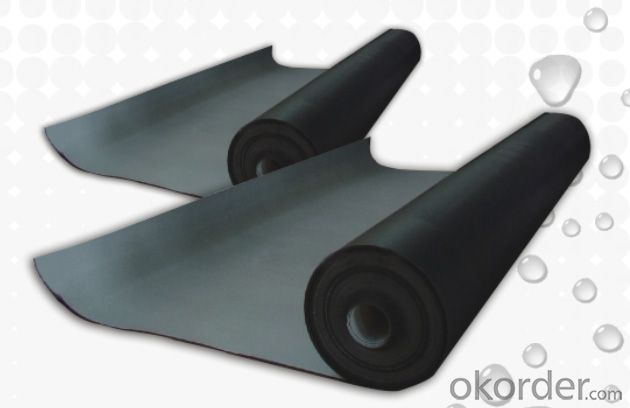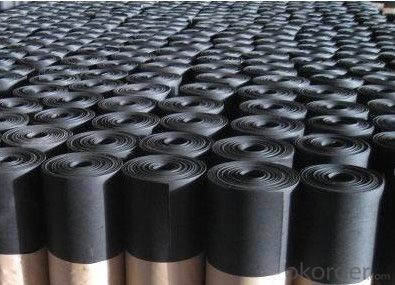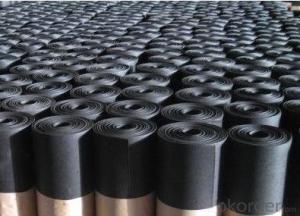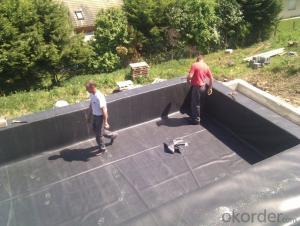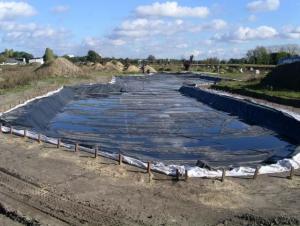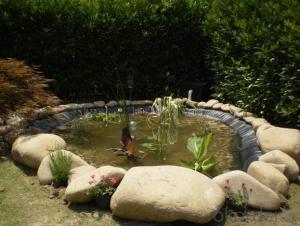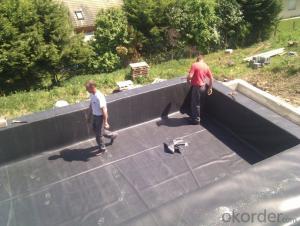EPDM Coiled Rubber Waterproof Membrane for Ponds
- Loading Port:
- Shanghai
- Payment Terms:
- TT or LC
- Min Order Qty:
- 10000 m²
- Supply Capability:
- 1200000 m²/month
OKorder Service Pledge
OKorder Financial Service
You Might Also Like
EPDM Coiled Rubber Waterproof Membrane for Ponds
Description Of EPDM Coiled Rubber Waterproof Membrane for Ponds:
1. EPDM waterproof membrane is made from ternary ethylene-propylene rubber, which is for waterproofing of exposed and non-exposed applications.
2. EPDM waterproof membrane production adopts the world-advanced equipment of cold feeding extrusion and continuous vulcanization technology.
3. EPDM waterproof membrane is of high elasticity among high polymer waterproof materials and becomes a world-popular waterproofing material.
Main Features of EPDM Coiled Rubber Waterproof Membrane for Ponds:
1. Excellent physical and mechanical performance
2. High tearing resistance
3. Good deformation adaptability
4. High puncture resistance
5. High aging resistance
6. UV resistance
Specifications of EPDM Coiled Rubber Waterproof Membrane for Ponds:
| Material | EPDM Rubber |
| Size | 1.2m (width)*20m (length) or customized, weldable type 2.05m or 4m width |
| Thick | 1.2mm, 1.5mm, 2.0mm |
| Type | Vulcanized & Weldable |
| Pattern | Non-reinforced (homogeneous) |
| Certificate | ISO9001/14001 |
Applications of EPDM Coiled Rubber Waterproof Membrane for Ponds:
1.Roofs, Basement, Toilets
2. Industrial and civil building waterproofing
3. Geosynthetic liner for swimming pool, channels, irrigation system
4. Especially suitable for projects with high requirements in durability, anti-corrosion and deformation.
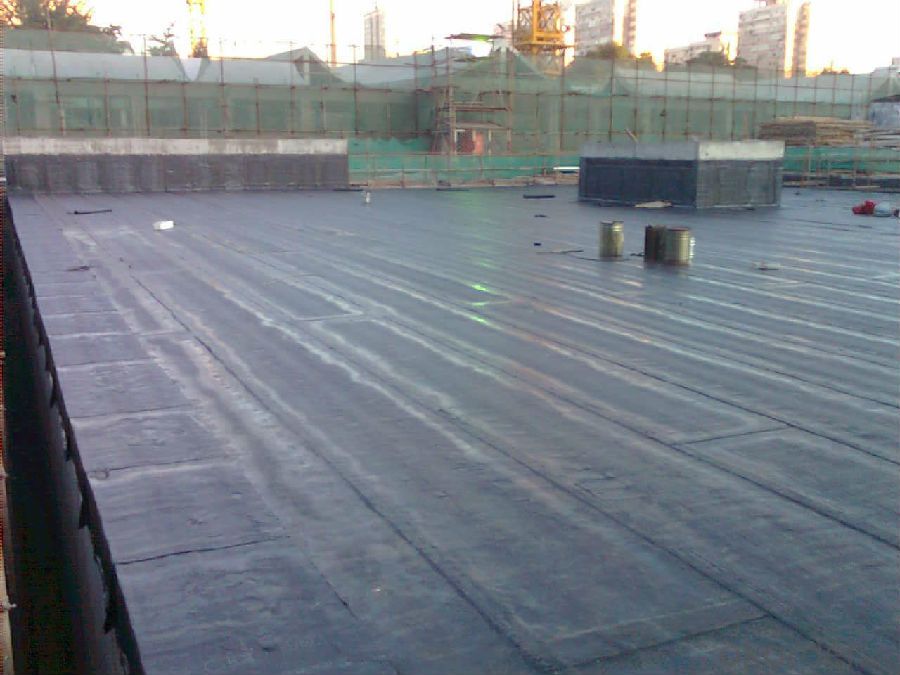
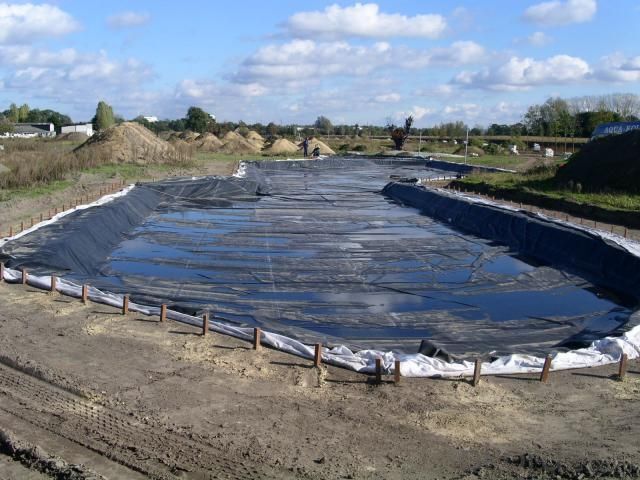

IMages of EPDM Coiled Rubber Waterproof Membrane for Ponds:
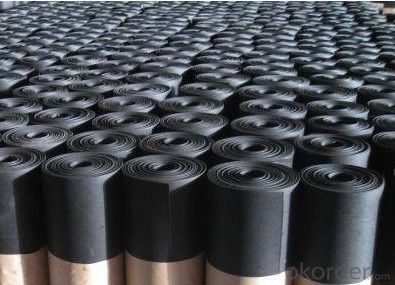



FAQ of EPDM Coiled Rubber Waterproof Membrane for Ponds:
1. What are we supplying?
We are specialized in producing Colorful Asphalt Roof Shingle, SBS/APP modified bitumen waterproof membrane, Self adhesive bitumen waterproof membrane, PVC waterproofing membrane, EPDM rubber roofing membrane, Single Component Polyurethane Waterproof Coating, and Spray Polyurea Waterproof Coating
.
2. How Many years experience do we have?
We have been exported to more than 20 countries in the past 15 years.
3. How long do we usually reply your request?
We always reply our customer within 24 hours.
- Q: Can a waterproofing membrane be used for underground utilities?
- Underground utilities can benefit from the use of a waterproofing membrane. These membranes are specifically designed to act as a barrier against water penetration, safeguarding the underlying structure from moisture damage. This becomes particularly significant for underground utilities, which face constant exposure to the surrounding soil and potential water seepage. Applying a waterproofing membrane to underground utilities, such as water pipes, sewer lines, or electrical conduits, aids in preventing water infiltration and subsequent corrosion or degradation of the materials. Acting as a protective layer, the membrane ensures that the utilities remain dry and free from moisture-related issues. Different types of waterproofing membranes are available, including sheet membranes, liquid membranes, and spray-applied membranes, each possessing unique properties and installation methods. The selection of the appropriate membrane relies on factors such as the specific utility, surrounding soil conditions, and additional requirements like chemical resistance or structural reinforcement. It is crucial to emphasize that proper installation and maintenance of the waterproofing membrane are vital for its effectiveness. Trained professionals should handle the installation, adhering to manufacturer guidelines and industry best practices. Regular inspections and maintenance are also necessary to ensure the membrane remains intact and functional over time. In conclusion, the utilization of a waterproofing membrane is indeed suitable for underground utilities. This application provides protection against water infiltration and preserves the integrity and longevity of the utilities.
- Q: How does a waterproofing membrane handle construction vibrations?
- A waterproofing membrane is designed to handle construction vibrations by providing a durable and flexible barrier that can withstand the movement and impact caused by these vibrations. The membrane is typically made of materials such as rubberized asphalt or synthetic polymers, which have excellent elasticity and tensile strength. When construction vibrations occur, the waterproofing membrane absorbs and dissipates the vibrations, preventing them from affecting the structural integrity of the building or compromising the waterproofing system. The flexibility of the membrane allows it to stretch and contract, accommodating the movement caused by vibrations without cracking or tearing. Additionally, some waterproofing membranes have added features like reinforced layers or fabric reinforcement, which further enhance their ability to withstand construction vibrations. These reinforcements provide additional strength and stability to the membrane, making it more resistant to damage from vibrations. It is important to note that the effectiveness of a waterproofing membrane in handling construction vibrations also depends on the quality of installation. Proper installation techniques, including adequate surface preparation and appropriate adhesion methods, ensure that the membrane is securely attached to the substrate, minimizing the risk of displacement or damage during construction activities. In summary, a waterproofing membrane is specifically designed to handle construction vibrations by absorbing and dissipating the impact, while maintaining its integrity and waterproofing capabilities. The flexibility and strength of the membrane, along with proper installation techniques, ensure that it can withstand the challenges posed by construction vibrations and provide long-lasting protection against water intrusion.
- Q: Are waterproofing membranes suitable for balconies and terraces?
- Yes, waterproofing membranes are suitable for balconies and terraces. These membranes are specifically designed to provide a protective barrier against water and moisture, preventing any potential damage to the structure of the balcony or terrace. Waterproofing membranes are typically made of materials such as rubber, bitumen, or PVC, which are highly resistant to water penetration. They are applied as a liquid, sheet, or spray, creating a seamless layer that covers the entire surface of the balcony or terrace. This ensures that no water can seep through and cause any structural issues, such as cracks, leaks, or deterioration. Additionally, waterproofing membranes can also protect against other forms of damage, such as mold growth or corrosion. Overall, using waterproofing membranes on balconies and terraces is an effective and recommended solution for maintaining their longevity and structural integrity.
- Q: How long does a waterproofing membrane typically last?
- The lifespan of a waterproofing membrane can vary depending on various factors such as the type and quality of the membrane, installation method, environmental conditions, and maintenance. However, on average, a properly installed and maintained waterproofing membrane can last anywhere from 10 to 20 years. Some high-quality membranes may even last longer, up to 30 years or more. It is important to note that regular maintenance, including inspections and repairs if necessary, can significantly extend the lifespan of a waterproofing membrane. Additionally, factors such as exposure to harsh weather conditions, ultraviolet (UV) radiation, chemicals, and foot traffic can affect the durability of the membrane and may require more frequent maintenance or replacement. To ensure the longevity of a waterproofing membrane, it is recommended to follow the manufacturer's guidelines for installation, maintenance, and repair. Regular inspections, especially after severe weather events or significant changes in the surrounding structures, are crucial to identify any potential issues and address them promptly. By taking proper care of the waterproofing membrane, you can maximize its lifespan and protect the underlying structure from water damage.
- Q: Can a waterproofing membrane be used on metal block surfaces?
- Metal block surfaces can indeed benefit from the use of a waterproofing membrane. These membranes are specifically designed to form a barrier against water and moisture, and they are versatile enough to be applied to various types of surfaces, including metal. By adhering to the metal surface, the membrane creates a protective layer that not only prevents water infiltration but also safeguards the metal against rust and corrosion. However, it is crucial to guarantee that the metal surface is thoroughly cleaned, dried, and appropriately prepared before the application of the waterproofing membrane. This preparation ensures optimal adhesion and effectiveness. For specific instructions on using a waterproofing membrane on metal block surfaces, it is highly recommended to consult a professional or refer to the manufacturer's guidelines.
- Q: Are waterproofing membranes resistant to chemical solvents?
- Yes, waterproofing membranes are generally resistant to chemical solvents. Most waterproofing membranes are designed to withstand exposure to various chemicals, including solvents. They are specifically formulated to provide a barrier against moisture and also protect against damage from chemical exposures. This resistance to chemical solvents is an important feature of waterproofing membranes, as it ensures their durability and effectiveness in a wide range of applications, such as in construction, roofing, and below-grade waterproofing. However, it is important to note that the specific resistance of a waterproofing membrane to chemical solvents can vary depending on the type and brand of membrane used, so it is always recommended to consult the manufacturer's guidelines for specific information on chemical resistance.
- Q: Can a waterproofing membrane be used in conjunction with concrete repair or restoration?
- Indeed, it is common practice to utilize a waterproofing membrane in conjunction with concrete repair or restoration. It is advisable to employ a waterproofing membrane as a safeguarding layer on top of repaired or restored concrete surfaces. This is due to the potential compromise of the original concrete's waterproofing properties during the repair or restoration process. Application of a waterproofing membrane guarantees the continued protection of the repaired or restored concrete against water infiltration, thereby preventing additional harm and deterioration. Moreover, the waterproofing membrane contributes to bolstering the overall strength and lifespan of the concrete structure.
- Q: Can a waterproofing membrane be used for parking garages?
- Yes, a waterproofing membrane can be used for parking garages. A waterproofing membrane is a protective layer that is applied on surfaces to prevent water penetration. In parking garages, it is essential to have effective waterproofing to protect the structure from water damage, such as corrosion of steel reinforcement and deterioration of concrete. Parking garages are exposed to various sources of water, including rain, snow, and vehicle fluids, which can seep through cracks and joints. A waterproofing membrane acts as a barrier, preventing water from infiltrating the structure and causing damage. There are different types of waterproofing membranes available for parking garages, including sheet membranes, liquid-applied membranes, and cementitious coatings. These membranes can be applied on horizontal and vertical surfaces, such as floors, walls, and ramps, to create a watertight seal. When selecting a waterproofing membrane for a parking garage, factors such as durability, flexibility, and resistance to chemicals should be considered. The membrane should be able to withstand the heavy loads and traffic conditions typically found in parking garages. Overall, using a waterproofing membrane in parking garages is crucial to protect the structure and extend its lifespan by preventing water-related damage. It helps maintain the structural integrity and aesthetics of the garage while ensuring a safe and functional environment for users.
- Q: Can a waterproofing membrane be used for roof gardens?
- Indeed, the utilization of a waterproofing membrane is applicable for roof gardens. In truth, it is strongly advised to implement a waterproofing membrane on the roof prior to establishing a garden in order to avert water leakage and harm to the underlying structure. Acting as a shield between the garden and the roof, the waterproofing membrane guarantees that water does not permeate through, thus preventing issues like leaks, mold, or structural destruction. It aids in safeguarding the roof against moisture, root intrusion, and other elements of the environment. Consequently, the inclusion of a waterproofing membrane is imperative for the prosperous and enduring installation of a roof garden.
- Q: Can a waterproofing membrane enhance the durability or lifespan of a structure?
- Yes, a waterproofing membrane can enhance the durability and lifespan of a structure by providing a protective barrier against water infiltration, preventing damage from moisture, leaks, and deterioration caused by water-related issues.
Send your message to us
EPDM Coiled Rubber Waterproof Membrane for Ponds
- Loading Port:
- Shanghai
- Payment Terms:
- TT or LC
- Min Order Qty:
- 10000 m²
- Supply Capability:
- 1200000 m²/month
OKorder Service Pledge
OKorder Financial Service
Similar products
Hot products
Hot Searches
Related keywords
